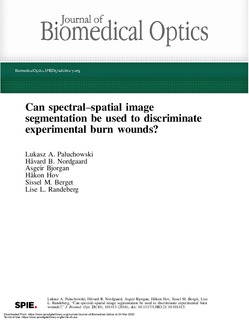| dc.contributor.author | Paluchowski, Lukasz A. | |
| dc.contributor.author | Nordgaard, Håvard B. | |
| dc.contributor.author | Bjorgan, Asgeir | |
| dc.contributor.author | Hov, Håkon | |
| dc.contributor.author | Berget, Sissel Marie | |
| dc.contributor.author | Randeberg, Lise Lyngsnes | |
| dc.date.accessioned | 2020-03-16T14:47:01Z | |
| dc.date.available | 2020-03-16T14:47:01Z | |
| dc.date.created | 2016-06-05T14:29:00Z | |
| dc.date.issued | 2016 | |
| dc.identifier.issn | 1083-3668 | |
| dc.identifier.uri | http://hdl.handle.net/11250/2647043 | |
| dc.description.abstract | Hyperspectral imaging (HSI) is a noncontact and noninvasive optical modality emerging the field of medical research. The goal of this study was to determine the ability of HSI and image segmentation to discriminate burn wounds in a preclinical porcine model. A heated brass rod was used to introduce burn wounds of graded severity in a pig model and a sequence of hyperspectral data was recorded up to 8-h postinjury. The hyperspectral images were processed by an unsupervised spectral–spatial segmentation algorithm. Segmentation was validated using results from histology. The proposed algorithm was compared to K-means segmentation and was found superior. The obtained segmentation maps revealed separated zones within the burn sites, indicating a variation in burn severity. The suggested image-processing scheme allowed mapping dynamic changes of spectral properties within the burn wounds over time. The results of this study indicate that unsupervised spectral–spatial segmentation applied on hyperspectral images can discriminate burn injuries of varying severity. | nb_NO |
| dc.language.iso | eng | nb_NO |
| dc.publisher | Society of Photo-optical Instrumentation Engineers (SPIE) | nb_NO |
| dc.rights | Navngivelse 4.0 Internasjonal | * |
| dc.rights.uri | http://creativecommons.org/licenses/by/4.0/deed.no | * |
| dc.title | Can spectral-spatial image segmentation be used to discriminate experimental burn wounds? | nb_NO |
| dc.type | Journal article | nb_NO |
| dc.type | Peer reviewed | nb_NO |
| dc.description.version | publishedVersion | nb_NO |
| dc.source.volume | 21:101413 | nb_NO |
| dc.source.journal | Journal of Biomedical Optics | nb_NO |
| dc.source.issue | 10 | nb_NO |
| dc.identifier.doi | 10.1117/1.JBO.21.10.101413 | |
| dc.identifier.cristin | 1359654 | |
| dc.description.localcode | © The Authors. Published by SPIE under a Creative Commons Attribution 3.0 Unported License. Distribution or reproduction of this work in whole or in part requires full attribution of the original publication, including its DOI. | nb_NO |
| cristin.unitcode | 194,63,35,0 | |
| cristin.unitcode | 1920,2,0,0 | |
| cristin.unitcode | 1920,14,0,0 | |
| cristin.unitcode | 194,65,15,0 | |
| cristin.unitname | Institutt for elektroniske systemer | |
| cristin.unitname | Kirurgisk klinikk | |
| cristin.unitname | Laboratoriemedisinsk klinikk | |
| cristin.unitname | Institutt for klinisk og molekylær medisin | |
| cristin.ispublished | true | |
| cristin.fulltext | original | |
| cristin.qualitycode | 2 | |

